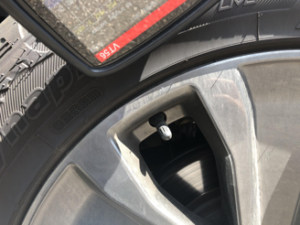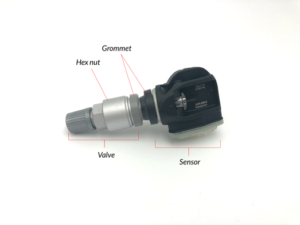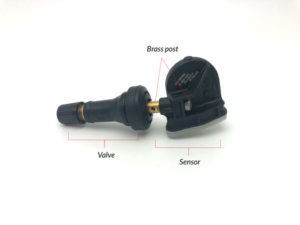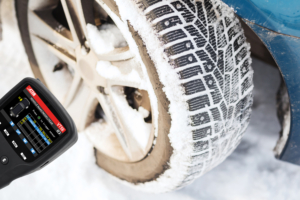Back to the news page
09.23.2018
Winter Tires and TPMS – TPMS sensor styles
There are two main styles of TPMS sensors that are offered in OE and aftermarket that are part of the valve stem assembly, including clamp-in and snap-in style sensors.

Clamp-in sensor assembled in wheel

Snap-in sensor assembled in wheel
Clamp-in sensors: Clamp-in sensors are mounted by the wheel’s valve hole and are secured with a hex nut, then sealed with a grommet. There are many different types of styles including fixed angle sensors where the sensor does not move, and adjustable clamp-in where the valve stem can fit with several OE and aftermarket rims. They are offered in one-piece designs and two-piece designs where the valve stem is one piece, and the sensor is another piece.

Snap-in sensors: Snap-in sensors can be attached from the inside of the tire, and are assembled in two pieces, where a brass or metal post separates the rubber valve stem and sensor.

 Many Asian and European vehicles are originally manufactured with clamp-in sensors, while most domestic vehicles are manufactured with snap-in sensors. When TPMS first came in production, there were issues with galvanic corrosion, causing damage to sensors. Today, this is not an issue since original manufactured and aftermarket sensors for clamp-in and snap-in use the upmost quality metal to prevent corrosion in winter environments.
Many Asian and European vehicles are originally manufactured with clamp-in sensors, while most domestic vehicles are manufactured with snap-in sensors. When TPMS first came in production, there were issues with galvanic corrosion, causing damage to sensors. Today, this is not an issue since original manufactured and aftermarket sensors for clamp-in and snap-in use the upmost quality metal to prevent corrosion in winter environments.
So which sensor style should you suggest to customers? Many drivers who have luxury vehicles or aftermarket rims prefer the look and appeal of clamp-in sensors. Most clamp-in sensors can also be adjusted to fit rims of larger or usual sizes. Snap-in sensors require less equipment to install, and in domestic vehicles, are more common as they are originally manufactured on the vehicle. It is best to ask your customer what look and style they prefer.
North America
Europe
Be sure your shop is educated and able to make the r...
Be sure your shop is educated and able to make the r...
Of all features in a vehicle, tires are one of the m...